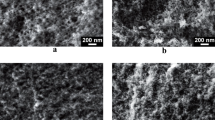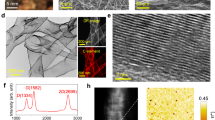Abstract
Four types of resorcinol–formaldehyde (RF) aerogels, stiff, brittle, low-flexible, and super-flexible are studied in this work. Despite several studies on mechanical properties on RF aerogels their response when exposed to compressive loading and their fracture behavior are not well investigated. Here, we cover aerogels with a very broad density range of 0.08–0.3 g cm−3 and compressive moduli from 0.12 to 28 MPa. We relate the microstructure of the synthesized aerogels and their behavior under uniaxial compression. Additionally, this work is the first, to our knowledge, to implement the usage of digital image correlation for characterizing the deformation of RF aerogels. The comparison of surface strain distribution of four types of aerogels provides an insight to their reaction on compressive loading.
















Similar content being viewed by others
References
Pekala RW (1989) Organic aerogels from the polycondensation of resorcinol with formaldehyde. J Mater Sci 24:3221–3227. doi:10.1007/BF01139044
Smith DM, Scherer GW, Anderson JM (1995) Shrinkage during drying of silica gel. J Non Cryst Solids 188:191–206. doi:10.1016/0022-3093(95)00187-5
Horikawa T, Hayashi J, Muroyama K (2004) Size control and characterization of spherical carbon aerogel particles from resorcinol-formaldehyde resin. Carbon 42:169–175. doi:10.1016/j.carbon.2003.10.007
Job N, Panariello F, Crine M, Pirard J-P, Léonard A (2007) Rheological determination of the sol–gel transition during the aqueous synthesis of resorcinol-formaldehyde resins. Colloid Surf A 293:224–228. doi:10.1016/j.colsurfa.2006.07.037
Saliger R, Bock V, Petricevic R, Tillotson T, Geis S, Fricke J (1997) Carbon aerogels from dilute catalysis of resorcinol with formaldehyde. J Non Cryst Solids 221:144–150
Horikawa T, Hayashi J, Muroyama K (2004) Controllability of pore characteristics of resorcinol-formaldehyde carbon aerogel. Carbon 42:1625–1633. doi:10.1016/j.carbon.2004.02.016
Lin C, Ritter J (1997) Effect of synthesis pH on the structure of carbon xerogels. Carbon 35:1271–1278
Awadallah-F A, Elkhatat AM, Al-Muhtaseb SA (2011) Impact of synthesis conditions on meso- and macropore structures of resorcinol-formaldehyde xerogels. J Mater Sci 46:7760–7769. doi:10.1007/s10853-011-5755-6
Job N, Panariello F, Marien J, Crine M, Pirard J-P, Léonard A (2006) Synthesis optimization of organic xerogels produced from convective air-drying of resorcinol-formaldehyde gels. J Non Cryst Solids 352:24–34. doi:10.1016/j.jnoncrysol.2005.11.024
Czakkel O, Marthi K, Geissler E, László K (2005) Influence of drying on the morphology of resorcinol-formaldehyde-based carbon gels. Microporous Mesoporous Mater 86:124–133. doi:10.1016/j.micromeso.2005.07.021
Yamamoto T, Nishimura T, Suzuki T, Tamon H (2001) Control of mesoporosity of carbon gels prepared by sol-gel polycondensation and freeze drying. J Non Cryst Solids 288:46–55
Gross J, Scherer GW, Alviso CT, Pekala RW (1997) Elastic properties of crosslinked resorcinol-formaldehyde gels and aerogels. J Non Cryst Solids 211:132–142. doi:10.1016/S0022-3093(96)00621-7
Pekala RW, Alviso CT, LeMay JD (1990) Organic aerogels: microstructural dependence of mechanical properties in compression. J Non Cryst Solids 125:67–75. doi:10.1016/0022-3093(90)90324-F
Yang J, Li S, Yan L, Liu J, Wang F (2010) Compressive behaviors and morphological changes of resorcinol-formaldehyde aerogel at high strain rates. Microporous Mesoporous Mater 133:134–140. doi:10.1016/j.micromeso.2010.04.025
Ashby MF, Medalist RFM (1983) The mechanical properties of cellular solids. Metall Trans A 14:1755–1769. doi:10.1007/BF02645546
Fricke J, Emmerling A (1998) Aerogels—recent progress in production techniques and novel applications. J Sol Gel Sci Technol 13:299–303. doi:10.1023/A:1008663908431
Schwan M, Ratke L (2013) Flexibilisation of resorcinol-formaldehyde aerogels. J Mater Chem A 1:13462–13468. doi:10.1039/C3TA13172F
Schwan M, Ratke L (2015) New soft and spongy resorcinol-formaldehyde aerogels. (In submission)
Wong JCH, Kaymak H, Brunner S, Koebel MM (2014) Mechanical properties of monolithic silica aerogels made from polyethoxydisiloxanes. Microporous Mesoporous Mater 183:23–29. doi:10.1016/j.micromeso.2013.08.029
Sachs C, Fabritius H, Raabe D (2006) Experimental investigation of the elastic-plastic deformation of mineralized lobster cuticle by digital image correlation. J Struct Biol 155:409–425. doi:10.1016/j.jsb.2006.06.004
Sachs C, Fabritius H, Raabe D (2008) Influence of microstructure on deformation anisotropy of mineralized cuticle from the lobster Homarus americanus. J Struct Biol 161:120–132. doi:10.1016/j.jsb.2007.09.022
Sachtleber M, Zhao Z, Raabe D (2002) Experimental investigation of plastic grain interaction. Mater Sci Eng A 336:81–87. doi:10.1016/S0921-5093(01)01974-8
GOM B (2007) Gesellschaft für Optische Messtechnik GmbH, Germany Handbook for the Aramis system
Mulik S, Sotiriou-Leventis C, Churu G, Lu H, Leventis N (2008) Cross-linking 3D assemblies of nanoparticles into mechanically strong aerogels by surface-initiated free-radical polymerization. Chem Mater 20:5035–5046. doi:10.1021/cm800963h
Sing KSW (1982) Reporting physisorption data for gas/solid systems with special reference to the determination of surface area and porosity (provisional). Pure Appl Chem 54:2201. doi:10.1351/pac198254112201
Kanamori K, Aizawa M, Nakanishi K, Hanada T (2007) New transparent methylsilsesquioxane aerogels and xerogels with improved mechanical properties. Adv Mater 19:1589–1593. doi:10.1002/adma.200602457
Gibson LJ, Ashby MF (1997) The mechanics of foams: basic results. In: Clarke DR, Suresh S, Ward IM (eds) Cellular solids. Structure and properties. Cambridge University Press, Cambridge, pp 175–234
Acknowledgements
The authors would like to acknowledge Mr Michael Adamek (MPIE, Duesseldorf) for great support with experiments.
Compliance with ethical standards
The manuscript “From hard to rubber-like: mechanical properties of resorcinol–formaldehyde aerogels” has not been submitted to other journal for simultaneous consideration. The manuscript has not been published previously. No data have been fabricated or manipulated (including images) to support our conclusions. Consent to submit has been received explicitly from all co-authors before the work is submitted. Authors whose names appear on the submission have contributed sufficiently to the scientific work and therefore share collective responsibility and accountability for the results.
Conflict of interest
The authors declare that they have no conflict of interest. The corresponding author collected the conflict of interest disclosure forms from all authors.
Author information
Authors and Affiliations
Corresponding author
Rights and permissions
About this article
Cite this article
Schwan, M., Naikade, M., Raabe, D. et al. From hard to rubber-like: mechanical properties of resorcinol–formaldehyde aerogels. J Mater Sci 50, 5482–5493 (2015). https://doi.org/10.1007/s10853-015-9094-x
Received:
Accepted:
Published:
Issue Date:
DOI: https://doi.org/10.1007/s10853-015-9094-x




